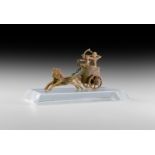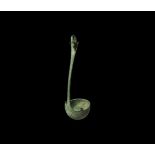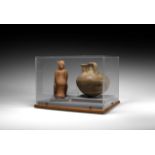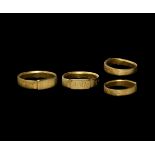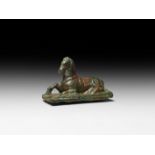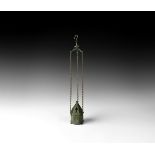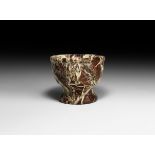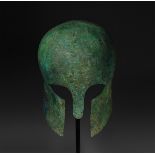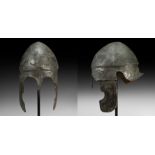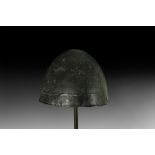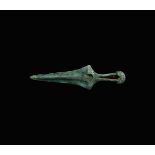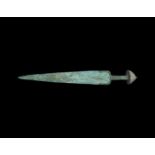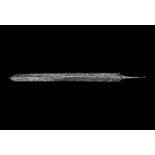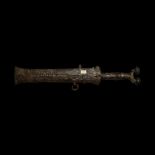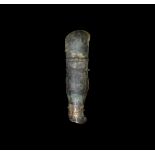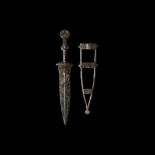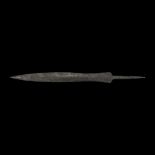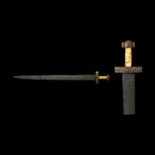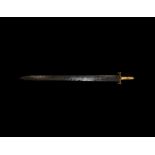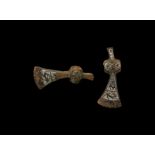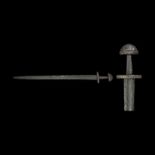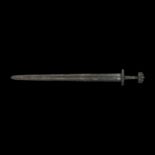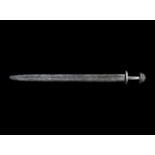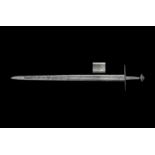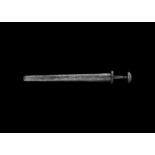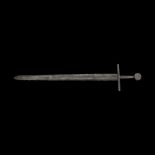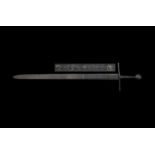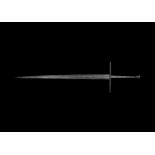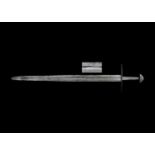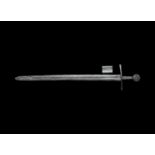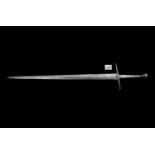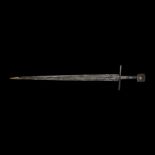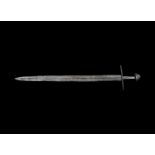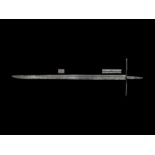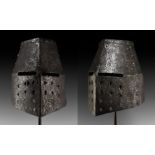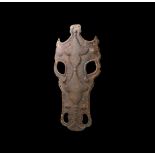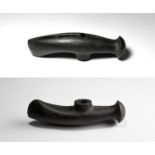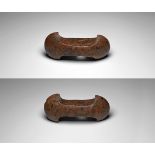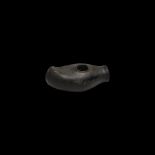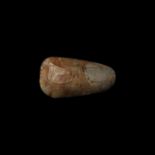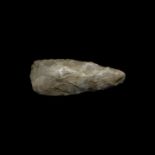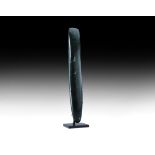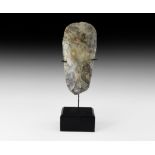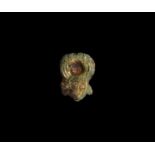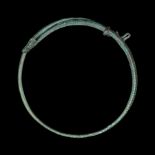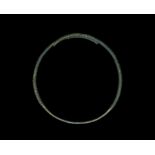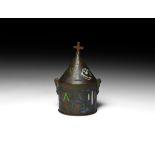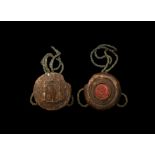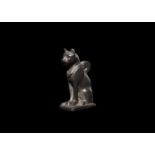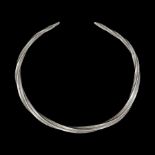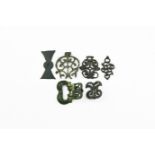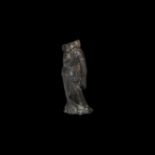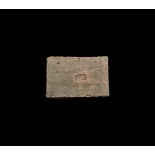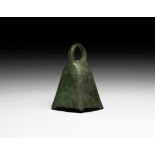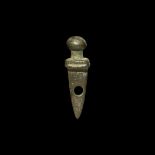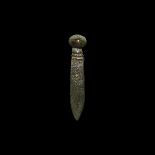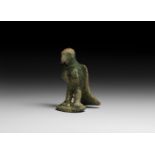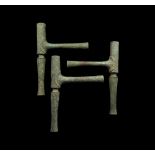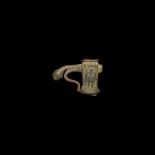Refine your search
Filtered by:
- Category,
- Item Type
- List
- Grid
A subscription to the Price Guide is required to view results for auctions ten days or older. Click here for more information
6th-4th century BC. A Phoenician or Assyrian carved ivory diorama representing a military archer or huntsman in his chariot; the vehicle a D-shape...
Late Etruscan Bronze Ladle
3rd-1st century BC. A bronze ladle with deep hemispherical bowl, two spurs to the rim flanking the tapering handle with spurs flanking the hook, d...
Late 2nd millennium BC-1st century BC. Two ceramic items: one goddess figure seated on a throne wearing draped garments and a headdress, facial de...
4th century AD. A gold finger ring with raised rectangular plaque, inscribed in seriffed capitals 'CONSTANTINO FIDEM' (faithful to Constantine"). ...
Roman Reclining Horse Statute
2nd century AD. A bronze statue of a reclining horse, wearing a saddle and a collar with breastplate around the neck; possibly a cart or furniture...
6th-8th century AD. A bronze hanging censer with three suspension chains attached to a three-armed distributor with collar and hook with notched f...
Western Asiatic Footed Mortar
1st millennium AD. A carved mottled red marble(?) mortar with pedestal base, deep bowl and rounded rim. 1.1 kg, 11cm (4 1/4"). Property of a North...
7th century BC. A bronze helmet of Archaic Corinthian typology made from a single sheet of metal, high bowl with large eye openings arching downwa...
Greek Chalcidian Helmet
5th-4th century BC. A Chalcidian type helmet formed as a bronze bowl with carination to the crown, flared edges at the ear openings and above the ...
Greek Helmet of Pilos Type
4th-3rd century BC. A sheet bronze helmet of Pilos type with slightly conical bowl, shallow carination above the gently flared rim, lateral holes ...
Mid 1st millennium BC. A bronze dagger with triangular-shaped blade and central midrib, separate bronze handle with openwork grip. 181 grams, 29.7...
2nd millennium BC. A substantial bronze short sword with broad triangular, double-edged blade and central midrib; crescent guard to the shoulders;...
Iron Age Celtic La Tene Sword
1st century BC-1st century AD. A double-edged sword of La Tène III type with deburred blade and raised midrib, slim tang with curved guard and qui...
5th-4th century BC. An iron two-edged dagger in its scabbard; the pommel of classic Celtiberian dual-antenna design, with biconvex lobe finials; c...
Roman Articulated Greave
Late 2nd-early 3rd century AD. A bronze greave (ocreae) for cavalry or infantry use, providing defence for the shin and knee, with a separate and ...
Roman Pugio with Scabbard
2nd-1st century BC. An iron pugio military dagger of Type I from the Republican period, comprising a short triangular blade with thick midrib and ...
Roman Gladius Sword Blade
Late 1st century BC-1st century AD. A double-edged iron gladius blade of Mainz typology, leaf-shaped waisted blade with slanted shoulders and tape...
5th-6th century AD. An iron two-edged sword with lentoid-section blade, the blade with battle nicks to both cutting edges and traces of scabbard r...
5th-6th century AD. A double-edged cutting sword with complete blade; the point is well preserved; both cutting edges with evidence of use on the ...
10th-13th century AD. An iron axehead of Wheeler's Type IV with curved blade and edge, bulbous socket, hammer to the reverse, featuring decorative...
Early 9th century AD. A double-edged sword of Petersen's Type E, Wheeler Type VII; the blade with fullers and signs of deployment on the battlefie...
10th century AD. An iron double-edged sword of Petersen's Type R with shallow fullers, an oval lower guard inlaid with copper and silver Ringerike...
Viking Double-Edged Sword
8th-9th century AD. A double-edged sword of Petersen's Distinctive Type 2 with tapering broad blade and shallow fullers, boat-shaped lower guard, ...
Mid 10th-mid 13th century AD. An iron double-edged Oakeshott's Type X and Petersen's Type X sword with elegant tapering blade and well-formed full...
Viking Single-Handed Sword
10th century AD. An iron double-edged sword of possibly Petersen's Type X, with pattern-welded blade and shallow fuller; boat-shaped crossguard gr...
Medieval Single-Handed Sword
Late 11th-early 12th century AD. A well-balanced iron double-edged sword of Oakeshott's Type XI or XII with gently tapering profile and round poin...
Late 13th century AD. An iron sword of Oakeshott's Type XIb or XII with double-edged blade and tapering profile with rounded point, shallow fuller...
Medieval Two-Handed Long Sword
14th-15th century AD. A two-handed sword of Oakeshott Type XVII, long diamond-section blade with fullers, straight guard of Oakeshott Style I, lon...
12th century AD. An elegant sword of Oakeshott's Type XI with long blade and well-marked fuller with an inlaid arrow motif, parallel-sided lower g...
12th-13th century AD. A beautifully proportioned double-edged iron sword of Oakeshott's Type XI with tapering profile and rounded point, shallow f...
Early 14th-early 15th century AD. An iron longsword of Oakeshott's Type XV.A or XVIII with tapering blade and shallow fullers, the blade inlaid wi...
Medieval Single-Handed Sword
Late 13th-early 14th century AD. An iron longsword of Oakeshott's Type XIIa with tapering blade and narrow fullers, edges of the blade with battle...
Medieval Single-Handed Sword
11th-12th century AD. A long iron sword of Oakeshott's Type XI with double-edged blade and narrow fullers, parallel-sided crossguard with tapering...
Late 15th-early 16th century AD. An single-edged iron sword possibly of German origin with 16th century hilt and pointed blade, two irregular full...
Medieval German Great Helm
Early 14th century AD. An impressive iron great helm of later typology, composed of five plates rivetted together; T-shaped nose guard with cross-...
Islamic Iron Chamfron
17th-18th century AD. A naturalistic iron chamfron with piercings for nostrils and eyes, four attachment holes to the edges. See Mohamed, B., The ...
Neolithic, late 3rd-early 2nd millennium BC. A large and finely polished boat-shaped axe in dark greenstone, with expanded asymmetric convex cutti...
Neolithic, 3rd-2nd millennium BC. A finely polished double-bitted stone axe with convex cutting edges flaring down into central rectangular sectio...
Neolithic, 3rd-2nd millennium BC. A finely polished battle axe in grey-green stone with asymmetric convex cutting edge curving to circular collare...
Neolithic, 7000-4000 BP. A finely polished axe of lentoid section with tapering edges and convex butt and convex cutting edge, showing some flakin...
Neolithic, 7th-4th millennium BP. A finely knapped axe with polished cutting edge of lentoid section with edges tapering from bluntly pointed butt...
Long Stone Age Polished Axehead
Neolithic, 5th-3rd millennium BC. A very long and superbly polished veined greenstone axe, probably of European origin, with slightly convex cutti...
Stone Age Danish Hand Axe
Nordic Passage Grave Culture, Lower Neolithic, 5th-4th millennium BC. A substantial knapped and polished chert axe blade with rounded butt, curved...
7th century AD. A gilt-bronze mount depicting a facing human mask with curved horns above the crown terminating in birds' heads, and small lateral...
9th-12th century AD. A copper-alloy faux-twisted neck-ring with stylised snake's head terminal and tail terminal; round-section median section and...
5th-8th century AD. A copper-alloy twisted neck-ring formed as a tapering shank with round-section median section, twisted bands and cruciform-sec...
14th century AD. A limoges bronze pyxis with enamelled fields to the sidewall and hinged conical lid, reserved scrolled tendrils to the sidewall a...
1576-1612 AD. A large wax document seal, discoid in plan with one flat ornamented face and gusset to the underside surrounding an inset red wax pa...
Egyptian Silver Cat Pendant
Saite Period, 624-525 BC. A silver pendant depicting a sitting cat, Bastet, the goddess of the home, domesticity, women's secrets, cats, fertility...
Greek Thracian Twisted Neck Torc
2nd century BC-1st century AD. A silver penannular torc with shank tapering to both ends, twisted around its own axis. See Hoddinott, R.F., The Th...
1st-2nd century AD. A mixed bronze group comprising: a gilt buckle loop and hinged plaque with attachment lugs to the reverse; a propeller belt-mo...
Roman Minerva Votive Offering
1st century BC-2nd century AD. A bronze female figurine in loose-fitting robe with tiered flounces, scale armour aegis to the shoulders and chest ...
1st century BC-1st century AD. A large rectangular ceramic tile with impressed manufacturer's stamp 'L V A[.]' for Legio V Alaudae, the 5th Legion...
Roman Bell with Loop
1st-3rd century AD. A bronze square-shaped bell with tapering body, loop handle above, small spur to each corner of the lower rim; remains of ferr...
Roman Cupid Statuette
2nd-3rd century AD. A bronze statuette depicting a naked winged flying Cupid, right arm raised in a greeting gesture, left arm slightly in movemen...
Roman Gladius Sword Amulet
1st century BC-1st century AD. A bronze miniature gladius votive or amulet with ribbed guard and knop finial; pierced through the blade. 4.5 gra...
Roman Gladius Sword Brooch
1st century BC-1st century AD. A bronze miniature gladius brooch with ribbed guard and knop finial; pin-lug and catchplate to the reverse. 5.3 g...
Roman Eagle Statuette
3rd century AD. A bronze military eagle (Aquila) figurine with its wings tucked in, large stylised head in frontal position, feather detailing to ...
1st-3rd century AD. A set of three bronze hollow-formed table legs, each a tubular socket above a narrow waist and tapering shank with flared end,...
Roman Dagger Fitting with Soldiers
1st-2nd century AD. A tubular bronze fitting with ribbed collar, a standing soldier holding a spear and shield to each side, a recurved extension ...

